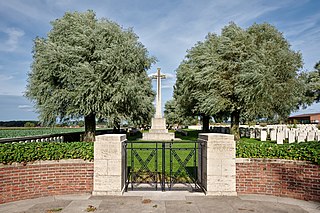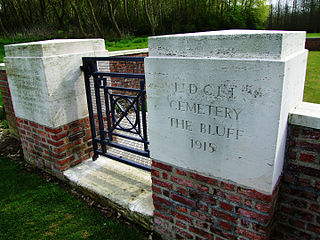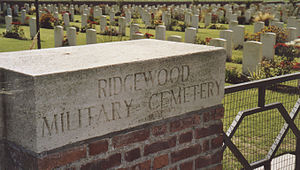
The Commonwealth War Graves Commission (CWGC) is an intergovernmental organisation of six independent member states whose principal function is to mark, record and maintain the graves and places of commemoration of Commonwealth of Nations military service members who died in the two World Wars. The commission is also responsible for commemorating Commonwealth civilians who died as a result of enemy action during the Second World War. The commission was founded by Sir Fabian Ware and constituted through Royal Charter in 1917 as the Imperial War Graves Commission. The change to the present name took place in 1960.

A war grave is a burial place for members of the armed forces or civilians who died during military campaigns or operations.

RE Grave, Railway Wood is a Commonwealth War Graves Commission (CWGC) memorial and war grave located in the Ypres Salient on the Western Front. It is located on the Bellewaerde Ridge near Zillebeke, about 4 kilometres east of Ypres, and a little north of Hooge. The area of the Cambridge Road sector, halfway in between Wieltje and Hooge, was the site of intensive underground fighting in the First World War. The Liverpool Scottish Memorial, Railway Wood is located nearby.

Fromelles is a commune in the Nord department in northern France. As of 2019 it had a population of 1,041; its inhabitants are called Fromellois. It is located about 16 kilometres (10 mi) to the west of Lille.

Duhallow ADSCemetery is a Commonwealth War Graves Commission burial ground for the dead of the First World War located near Ypres on the Western Front in Belgium.

Hooge Crater Cemetery is a Commonwealth War Graves Commission burial ground for the dead of the First World War located in the Ypres Salient in Belgium on the Western Front. Hooge Crater Cemetery is named after a mine crater blown nearby in 1915 and located near the centre of Hooge, opposite the "Hooge Crater Museum" and separated from it by the Menin Road. Hooge itself is a small village on the Bellewaerde Ridge, about 4 kilometres east of Ypres in the Flemish province of West Flanders.

Elzenwalle Brasserie Cemetery is a Commonwealth War Graves Commission burial ground for the dead of the First World War located near Ypres on the Western Front in Belgium.

Bedford House Cemetery is a Commonwealth War Graves Commission burial ground for the dead of the First World War located near Zillebeke, itself near Ypres, on the Western Front in Belgium.

Menin Road South Military Cemetery is a Commonwealth War Graves Commission burial ground for the dead of the First World War located near Ypres, on the Western Front.

Potijze Burial Ground Cemetery is a Commonwealth War Graves Commission (CWGC) burial ground for the dead of the First World War located in the Ypres Salient on the Western Front.

Potijze Château Lawn and Grounds Cemeteries are Commonwealth War Graves Commission (CWGC) burial grounds for the dead of the First World War located in the Ypres Salient on the Western Front.

Potijze Château Wood Cemetery is a Commonwealth War Graves Commission (CWGC) burial ground for the dead of the First World War located in the Ypres Salient on the Western Front.

Ploegsteert Wood Military Cemetery is a Commonwealth War Graves Commission (CWGC) burial ground for the dead of the First World War located in the Ypres Salient within Ploegsteert Wood on the Western Front in Belgium.

PerthCemetery is a Commonwealth War Graves Commission burial ground for the dead of the First World War located near Ypres (Ieper) in Belgium on the Western Front.

Woods Cemetery is a Commonwealth War Graves Commission burial ground for the dead of the First World War located near The Bluff south of Ypres (Ieper) in Belgium on the Western Front.

First DCLI Cemetery, The Bluff is a Commonwealth War Graves Commission burial ground for the dead of the First World War located near The Bluff south of Ypres (Ieper) in Belgium on the Western Front. It takes its name from the Duke of Cornwall's Light Infantry (DCLI).

The St Symphorien Military Cemetery is a First World War Commonwealth War Graves Commission burial ground in Saint-Symphorien, Belgium. It contains the graves of 284 German and 229 Commonwealth soldiers, principally those killed during the Battle of Mons. The cemetery was established by the German Army on land donated by Jean Houzeau de Lehaie. It was initially designed as a woodland cemetery before being redesigned by William Harrison Cowlishaw after the Imperial War Graves Commission took over maintenance of the cemetery after the war.

Lijssenthoek Military Cemetery is a Commonwealth War Graves Commission (CWGC) burial ground for the dead of the First World War in the Ypres Salient on the Western Front. After Tyne Cot, it is the second largest cemetery for Commonwealth forces in Belgium. Lijssenthoek Military Cemetery is located near Poperinge in the province of West Flanders. Most of those buried in the cemetery are war casualties who had been wounded near Ypres and later died in the four large Allied casualty clearing stations located in this area.

In World War I, the area around Hooge on Bellewaerde Ridge, about 2.5 mi (4 km) east of Ypres in Flanders in Belgium, was one of the easternmost sectors of the Ypres Salient and was the site of much fighting between German and Allied forces.



















